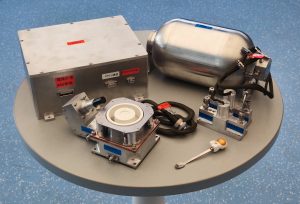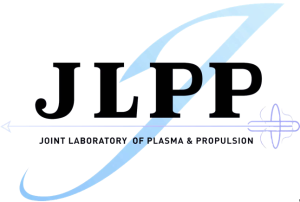Our research
Hall thuster
In spacecraft propulsion, a Hall-effect thruster (HET) is a type of ion thruster in which the propellant is accelerated by an electric field. Hall-effect thrusters (based on the discovery by Edwin Hall) are sometimes referred to as Hall thrusters or Hall-current thrusters. Hall-effect thrusters use a magnetic field to limit the electrons’ axial motion and then use them to ionize propellant, efficiently accelerate the ions to produce thrust, and neutralize the ions in the plume. The Hall-effect thruster is classed as a moderate specific impulse (1,600 s) space propulsion technology and has benefited from considerable theoretical and experimental research since the 1960s.

The principal of Hall thruster
Hall thrusters operate on a variety of propellants, the most common being xenon and krypton. Other propellants of interest include argon, bismuth, iodine, magnesium, zinc and adamantane.
Hall thrusters are able to accelerate their exhaust to speeds between 10 and 80 km/s (1,000–8,000 s specific impulse), with most models operating between 15 and 30 km/s. The thrust produced depends on the power level. Devices operating at 1.35 kW produce about 83 mN of thrust. High-power models have demonstrated up to 5.4 N in the laboratory. Power levels up to 100 kW have been demonstrated for xenon Hall thrusters.
As of 2009, Hall-effect thrusters ranged in input power levels from 1.35 to 10 kilowatts and had exhaust velocities of 10–50 kilometers per second, with thrust of 40–600 millinewtons and efficiency in the range of 45–60 percent. The applications of Hall-effect thrusters include control of the orientation and position of orbiting satellites and use as a main propulsion engine for medium-size robotic space vehicles. (from Wikipedia)

Beihang Hall thruster
In our lab, we have developed the cylindrical Hall-effect thruster and several stationary plasma thrusters. The designed stationary plasma thrusters use permanent magnets as the magnetic field source, and a variety of Hall-effect thrusters with power ranges from 100 W to 800 W and thrust ranges from 5 mN to 30 mN, as well as supporting gas storage and power process and control units, can form a complete Hall electric propulsion system.
In the third quarter of 2022, the 100W Hall-effect thruster developed by the laboratory will go into space with Qilu-3 satellite, starting a years-long propulsion effort. This is the first time for our Hall-effect thruster to go into space. In the future, there will be several other Hall-effect thrusters with krypton gas masses from our laboratory on missions in space.

Beihang Hall thruster on operation
Featured articles:
[1] Jiang, Yiwei, Haibin Tang, Junxue Ren, Min Li, and Jinbin Cao. “Magnetic mirror effect in a cylindrical Hall thruster.” Journal of Physics D: Applied Physics 51, no. 3 (2017): 035201.
[2] ZHANG, Guangchuan, R. E. N. Junxue, Wei LIANG, Ning OUYANG, L. U. Chao, and T. A. N. G. Haibin. “Coupling plasma plume of a low-power magnetically shielded Hall thruster with a hollow cathode.” Chinese Journal of Aeronautics 33, no. 12 (2020): 3018-3026.
[3] Zhang, Guangchuan, Junxue Ren, Haibin Tang, Zhe Zhang, and Jinbin Cao. “Magnetic field deflection in a 100 W Hall thruster with permanent magnets.” Plasma Sources Science and Technology (2022).
[4] Zhang, Guangchuan, Junxue Ren, Haibin Tang, Zhe Zhang, Yifeng Fu, Zhongkai Zhang, and Jinbin Cao. “Plasma diagnosis of an Unclosed E× B Drift Thruster with visible ionization zone.” Plasma Sources Science and Technology (2022).
[5] Zhang, Zhongkai, Zun Zhang, Yimeng Wang, Guangchuan Zhang, Jiayun Qi, Jiubin Liu, Haibin Tang, and Jinbin Cao. “Simultaneous experimental verification of indirect thrust measurement method based on Hall-effect thruster and plasma plume.” Vacuum 204 (2022): 111384.
(Lastly Updated in September, 2022)
